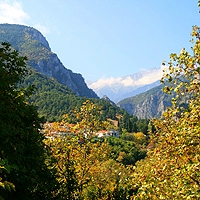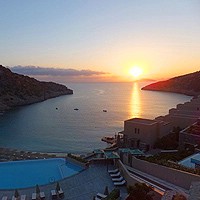Mosaic of Central Macedonia
 A “fasten seat belt” light came on above the seats, and a few minutes later the liner emerged from the impenetrable shroud. A land appeared, above which clouds hung in shreds of white cotton. Scattered upward, they looked more like smoke from campfires — as if in each flap of an unevenly cut blanket the open fires were simultaneously extinguished. The chassis, touching the ground, as if in syllables, squealed with brakes: “Sa-lo-ni-ki.” The reverse buzzed and the plane rolled smoothly along the strip towards the airport …
A “fasten seat belt” light came on above the seats, and a few minutes later the liner emerged from the impenetrable shroud. A land appeared, above which clouds hung in shreds of white cotton. Scattered upward, they looked more like smoke from campfires — as if in each flap of an unevenly cut blanket the open fires were simultaneously extinguished. The chassis, touching the ground, as if in syllables, squealed with brakes: “Sa-lo-ni-ki.” The reverse buzzed and the plane rolled smoothly along the strip towards the airport …
Central Macedonia is the most visited tourist region of Greece. Well deserved: is it possible to avoid the temptation of a rich ancient history, the azure sea and the wonderful natural beauty?
Most of the tourists who have decided to surrender to the tourist temptation and imbued with the charms of Macedonia, choose Thessaloniki as the first point of their route. Of course, partly, because this is the main transportation hub since the times of the Byzantine Empire, when the city competed with Constantinople itself. And today the city has not lost its greatness and is the second largest in Greece. It is still the most important commercial center connecting Greece with the countries of Southern Europe.
Thessaloniki – a city that never sits still and in constant motion implements limitless plans to transform itself – the most courageous ones today concern the embankment area. Thessaloniki is the center of intellectual and artistic life in modern Greece. Here you can visit a wide variety of exhibitions, go to museums, theaters. The International Thessaloniki Film Festival is held here every fall.
But purposefully looking into the future, Thessaloniki do not forget about their past. The city’s image depicts the turbulent history of Macedonia as a whole: for centuries, its masters were the Romans, Byzantines, Ottoman Turks. All of them contributed to the cultural mosaic of the city. Evidence of the city’s impressive heritage can be found in an area known as Ano Poli. This picturesque area with well-groomed avenues and old houses is the highest point of the city. On a clear day from here you can see the distant peaks of Olympus.
Thessaloniki is known as a unique open-air museum of Byzantine art. Many interesting historical sights are scattered around the city. Of particular interest are the tombs of King Philip (father of Alexander the Great) with golden sarcophagi, valuable utensils and weapons, as well as the excavations of ancient Pella, the first capital of the Macedonian kingdom. From the village of Litohoron in the vicinity of Thessaloniki begins the route of climbing Mount Olympus.
Not far from the capital of the nome Pella of the ancient city of Edessa, at the foot of Vora, lies the village of Loutraki, famous for its hot springs. From all over Greece lovers flock here to enjoy the healing properties of the water and combine this pleasant event with walks in the fresh air through the scenic area, and also, depending on the season, skiing in Kaimaktsalan, climbing, speleology and trekking along the gorge.
To the south of the capital of Macedonia lies the three-toed peninsula of Chalkidiki. Kassandra – the most western finger of the peninsula, the closest located to Thessaloniki, is the most densely populated and popular place in Halkidiki. Sandy beaches, pine forests and mild climate attract tourists from many countries. Sithonia – the middle finger is characterized by lush nature, calm atmosphere and beautiful landscape, fishing villages alternate with picturesque small harbors and deserted beaches. The last finger, Athos, is closed for mass tourists, although it is the most beautiful. For centuries, Athos – the abode of monks and hermits, there are 20 monasteries.
If you are planning your visit to Central Macedonia in the summer, it is worthwhile to coincide with a trip to visit the annual festival of music and theatrical art “Olympus”, held in the ancient theater of the Pieria region – Dione. However, outside the festival, Dion deserves special attention – since 1983, visitors have been receiving the Archaeological Museum of Dion, which exhibits items found during excavations in the ancient city and the sanctuary. The exhibition includes statues, funerary monuments, coins and other artifacts found during the excavations of Dion.
The Pieria region itself is one of the most frequently visited areas of Greece, and it is here that the highest peak of Greece is located – the famous Mount Olympus (2917 meters). On the slopes of Olympus scattered picturesque villages. Even in ancient times, the beauty of these places was sung by ancient poets – Homer and Euripides. In 1981, Olympus was declared by UNESCO as a natural reserve of world importance.
North of Thessaloniki, near the charming town of Serres, is Lake Kerkinis. Kerkinis is one of 11 Greek water reserves of international importance. Here you will find unforgettable boat trips in the harbor of Kerkini. Every season the landscape and birds change. In spring and summer you can see herons, spoonbills, dwarf cormorants in the places of their nesting.


